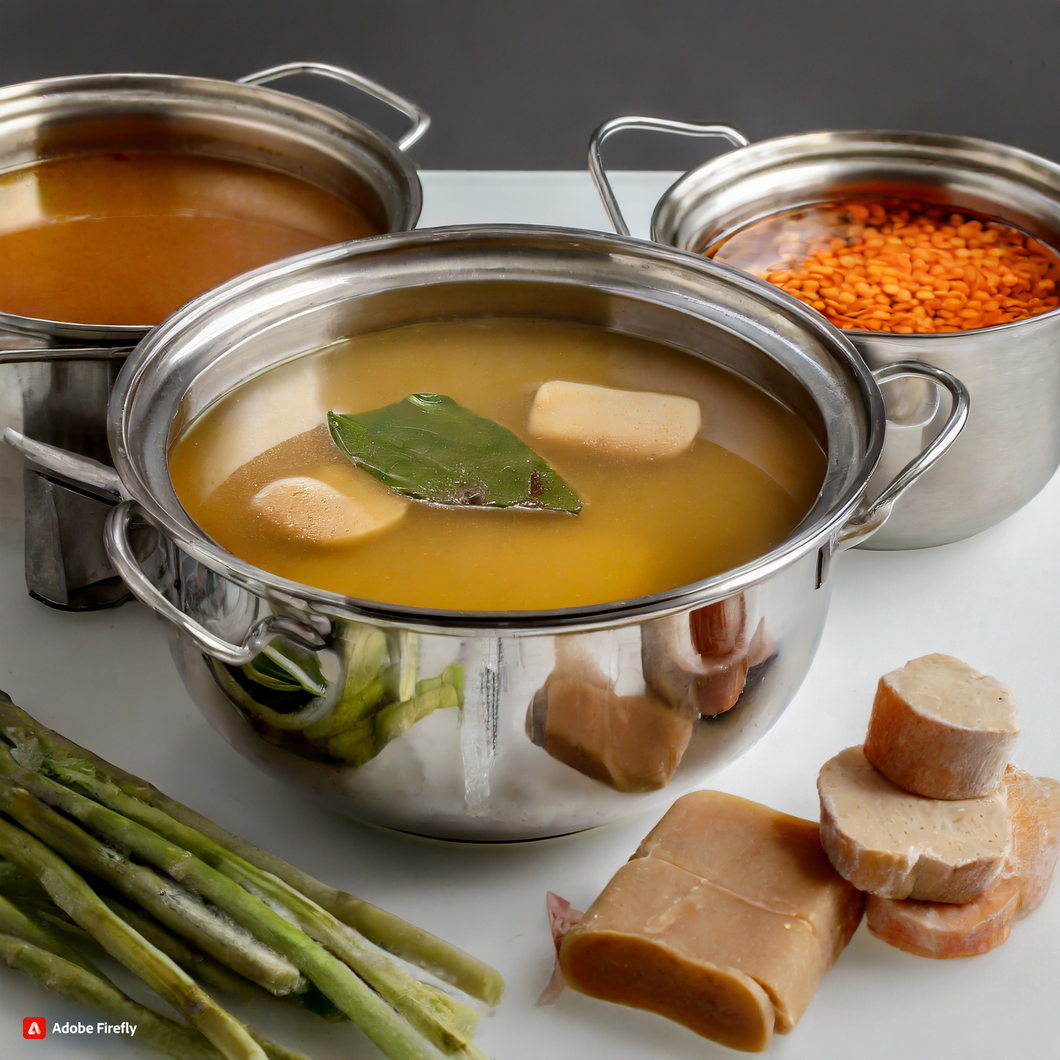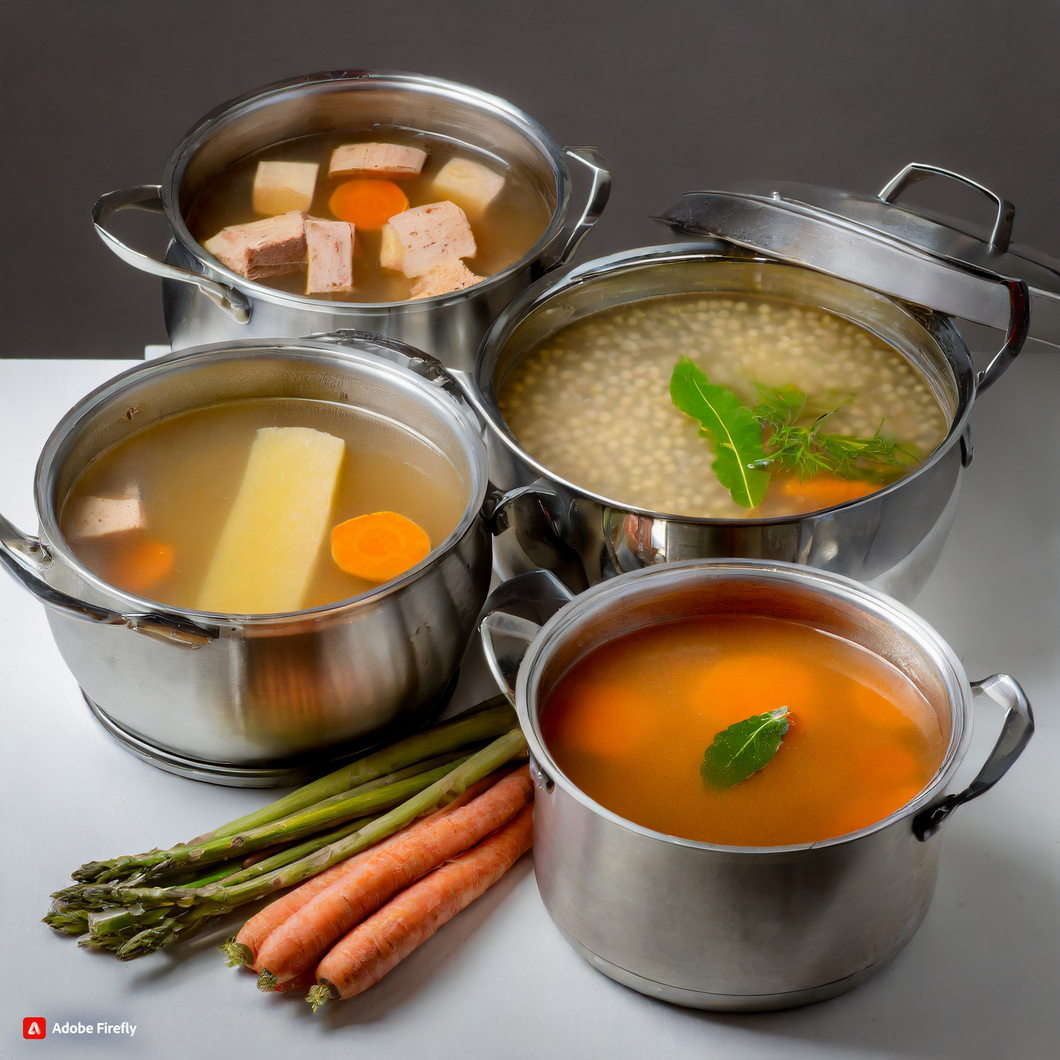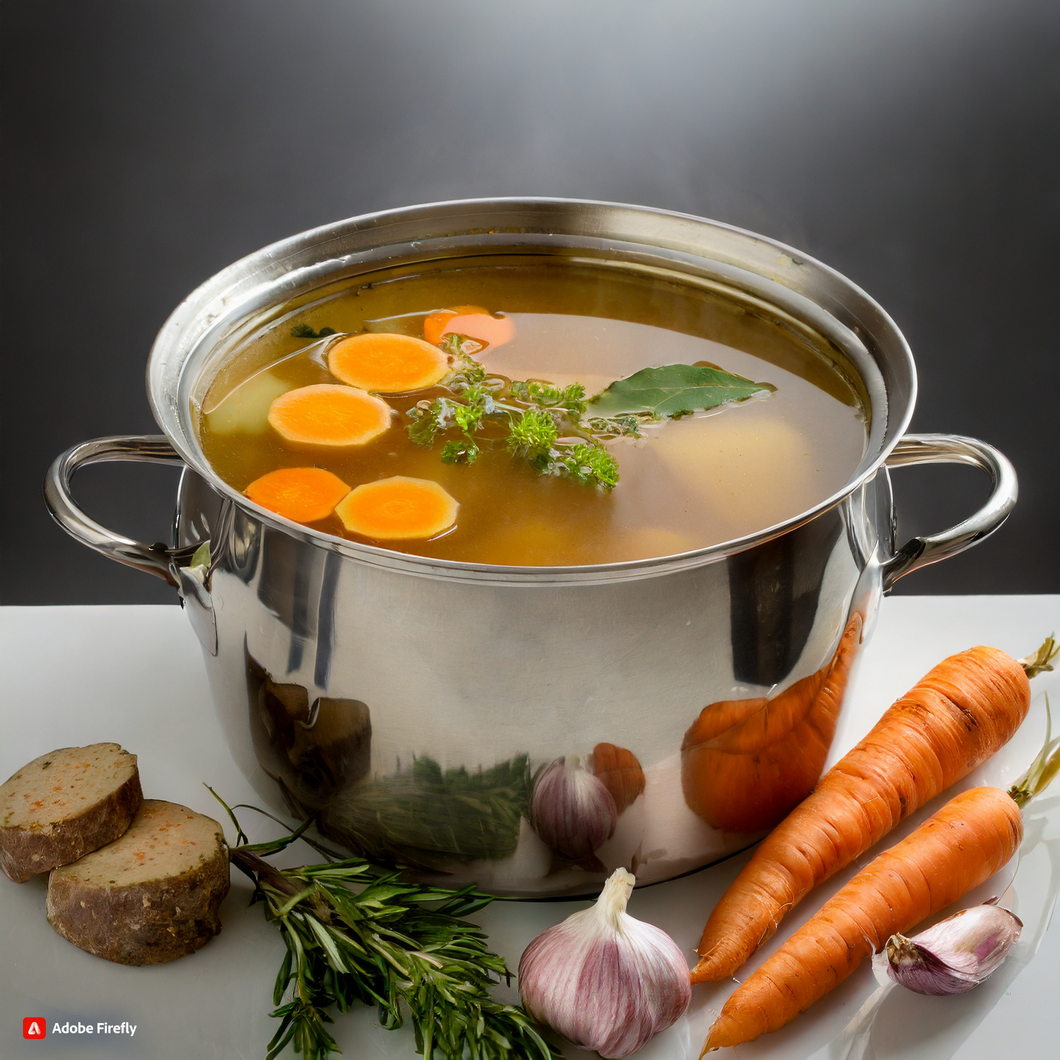Introduction
Difference Broth and Stock, Broth and stock are two commonly used terms in cooking, often used interchangeably. However, there are some key differences between the two that can affect the outcome of a dish. In this introduction, we will explore the differences between broth and stock and how they can impact your cooking.
5 Key Differences Between Broth and Stock You Need to Know

If you’re a food lover, you’ve probably come across the terms “broth” and “stock” in recipes or on restaurant menus. While they may seem like interchangeable words, there are actually some key differences between the two. In this article, we’ll break down the main differences between broth and stock, so you can confidently use them in your cooking and impress your friends with your culinary knowledge.
1. Ingredients
The first and most obvious difference between broth and stock is the ingredients used to make them. Broth is typically made with meat, vegetables, and herbs, while stock is made with bones, vegetables, and herbs. This means that broth has a more meaty and flavorful taste, while stock has a richer and more gelatinous texture.
2. Cooking Time
Another key difference between broth and stock is the cooking time. Broth is usually cooked for a shorter period of time, around 1-2 hours, while stock is cooked for a longer period of time, usually 4-6 hours. This longer cooking time allows the bones to release more flavor and nutrients, resulting in a more concentrated and flavorful stock.
3. Purpose
Broth and stock also have different purposes in cooking. Broth is often used as a base for soups, stews, and sauces, while stock is used as a base for more complex dishes such as risotto or braised meats. Broth is also commonly used as a remedy for colds and flu, as it is believed to have healing properties.
4. Seasoning
When it comes to seasoning, broth and stock also differ. Broth is usually seasoned with salt and pepper, while stock is left unseasoned. This is because stock is often used as a building block in recipes, and the seasoning can be adjusted later on. Broth, on the other hand, is meant to be consumed on its own, so it needs to be seasoned to taste.
5. Storage
Finally, the way broth and stock are stored also sets them apart. Broth can be stored in the refrigerator for up to 4 days, while stock can be stored for up to 6 months in the freezer. This is because stock has a higher concentration of gelatin, which acts as a natural preservative. It’s important to note that both broth and stock should be stored in airtight containers to prevent bacteria growth.
So, which one should you use in your cooking? The answer depends on the dish you’re making. If you’re making a soup or stew that requires a rich and flavorful base, broth is the way to go. If you’re making a more complex dish that requires a deeper and more concentrated flavor, stock is the better choice.
In conclusion, while broth and stock may seem similar, they have distinct differences in terms of ingredients, cooking time, purpose, seasoning, and storage. Knowing these differences can help you choose the right one for your dish and elevate your cooking game. So next time you’re in the kitchen, remember the difference between broth and stock and impress your taste buds with a perfectly crafted dish.
Broth vs. Stock: Understanding the Distinctions and How to Use Them in Cooking
When it comes to cooking, there are many terms that can be confusing, especially for beginners. One of the most common questions that arise is the difference between broth and stock. While these two terms are often used interchangeably, there are actually distinct differences between them. In this article, we will dive into the distinctions between broth and stock and how to use them in cooking.
First, let’s start with the basics. Both broth and stock are flavorful liquids that are used as a base for soups, stews, and sauces. They are made by simmering meat, bones, vegetables, and herbs in water for an extended period of time. The main difference between the two lies in their ingredients and cooking methods.

Broth is typically made with meat, vegetables, and herbs, while stock is made with bones, vegetables, and herbs. This means that broth has a more pronounced meaty flavor, while stock has a richer and more gelatinous texture. Broth is also usually seasoned with salt and other spices, while stock is left unseasoned to allow for more versatility in cooking.
Another key difference between broth and stock is the cooking time. Broth is usually cooked for a shorter period of time, around 1-2 hours, while stock is simmered for a longer period, usually 4-6 hours. This longer cooking time allows for the bones to release more collagen, giving stock its gelatinous texture and making it a great base for sauces and gravies.
So, when should you use broth and when should you use stock in your cooking? The answer lies in the dish you are making. Broth is best used in dishes where the meat is the star, such as soups and stews. Its rich and flavorful taste adds depth to the dish without overpowering the other ingredients. On the other hand, stock is better suited for dishes that require a more subtle flavor, such as risotto or sauces. Its gelatinous texture also helps to thicken sauces and add a silky mouthfeel.
One thing to keep in mind is that broth and stock are not interchangeable in all recipes. For example, if a recipe calls for stock, using broth instead may result in a dish that is too salty or lacks the desired texture. However, if a recipe calls for broth, you can use stock instead, but you may need to adjust the seasoning to your taste.
Now that we have covered the differences between broth and stock, let’s talk about how to make them at home. While store-bought broth and stock are convenient, making them from scratch is not only more cost-effective but also allows you to control the ingredients and flavors. To make broth, simply simmer meat, vegetables, and herbs in water for 1-2 hours. For stock, use bones, vegetables, and herbs and simmer for 4-6 hours. You can also add in aromatics like onions, garlic, and ginger to enhance the flavor.
Once your broth or stock is ready, you can store it in the fridge for up to 3 days or freeze it for later use. When freezing, make sure to leave some room in the container for expansion. You can also freeze broth or stock in ice cube trays for easy portioning.
In conclusion, while broth and stock may seem similar, they have distinct differences in their ingredients, cooking methods, and uses in cooking. Broth is made with meat and has a shorter cooking time, while stock is made with bones and has a longer cooking time. Knowing when to use broth or stock in your cooking will elevate your dishes and add depth of flavor. So next time you’re in the kitchen, remember the difference between broth and stock and use them accordingly to create delicious and flavorful meals.
The Debate Between Broth and Stock: Which One is Better for Your Health?
When it comes to cooking, there are many terms that can be confusing, especially for beginners. One of the most common debates in the culinary world is the difference between broth and stock. While both are used as a base for soups, stews, and sauces, they are not interchangeable. In fact, there are distinct differences between the two that can affect the taste and health benefits of your dishes. So, let’s dive into the debate between broth and stock and find out which one is better for your health.
First, let’s define what broth and stock are. Broth is a flavorful liquid made by simmering meat, vegetables, and herbs in water. It is usually seasoned with salt and can be consumed on its own as a warm and comforting drink. On the other hand, stock is a liquid made by simmering bones, vegetables, and herbs in water. It is not seasoned and is used as a base for other dishes. Both broth and stock can be made with various ingredients, but the main difference lies in the cooking process and the ingredients used.

One of the main differences between broth and stock is the cooking time. Broth is usually cooked for a shorter period, around 1-2 hours, while stock is simmered for a longer time, usually 4-6 hours. This longer cooking time allows the bones to release more collagen, which gives stock a thicker and richer texture. Broth, on the other hand, has a lighter consistency and is more flavorful due to the addition of meat and vegetables.
Another difference between broth and stock is the ingredients used. Broth is typically made with meat, while stock is made with bones. This is because bones contain more collagen, which gives stock its gelatinous texture. Broth, on the other hand, is made with meat, which adds more flavor to the liquid. However, this also means that broth has a higher fat content compared to stock. So, if you are looking for a healthier option, stock might be the better choice.
Speaking of health, let’s talk about the nutritional differences between broth and stock. Both are considered to be nutritious, but they have different health benefits. Broth is rich in protein, vitamins, and minerals, making it a great source of nutrients. It is also known to have anti-inflammatory properties and can help boost the immune system. On the other hand, stock is rich in collagen, which is beneficial for joint health, skin, and hair. It is also a good source of calcium, magnesium, and phosphorus. So, depending on your health needs, you can choose between broth and stock.
Now, let’s address the elephant in the room – the sodium content. Both broth and stock can be high in sodium, especially if you use store-bought versions. However, you can control the amount of salt in your homemade broth or stock. You can also opt for low-sodium or no-salt-added versions if you are watching your sodium intake. Additionally, you can use herbs and spices to add flavor to your broth or stock instead of relying on salt. Read easy Healthy Lunch for Weight Loss.
In conclusion, the debate between broth and stock is not about which one is better, but rather which one is more suitable for your needs. Broth is perfect for sipping on a cold day or as a base for soups and stews. It is also a great source of protein and nutrients. On the other hand, stock is ideal for adding depth and richness to your dishes. It is also rich in collagen and minerals, making it beneficial for your health. So, the next time you are in the kitchen, consider the differences between broth and stock and choose the one that best fits your taste and health needs.
Q&A – Difference Broth and Stock
Q: What is the difference between broth and stock?
A: Broth is typically made by simmering meat and vegetables, while stock is made by simmering bones and vegetables. Broth also tends to have a richer, more intense flavor compared to stock.
Q: Are there any other differences between broth and stock?
A: Yes, broth is usually seasoned with herbs and spices, while stock is left unseasoned. Broth is also typically used as a base for soups and stews, while stock is used as a base for sauces and gravies.
Q: Can broth and stock be used interchangeably in recipes?
A: It is not recommended to use broth and stock interchangeably in recipes, as they have different flavors and consistencies. However, in a pinch, you can substitute one for the other, but the end result may be slightly different.
Conclusion for Difference Broth and Stock
In conclusion for Difference Broth and Stock, while both broth and stock are flavorful liquids used in cooking, there are some key differences between the two. Broth is typically made by simmering meat and vegetables, while stock is made by simmering bones and vegetables. Broth also tends to have a richer, more intense flavor, while stock is more neutral and can be used as a base for other dishes. Additionally, broth is often used as a standalone dish, while stock is primarily used as an ingredient in other recipes. Ultimately, the main difference between broth and stock lies in their ingredients and intended uses.
Please follow us on linkedin. You can learn all best canadian food recipes you can check our Culinary 1TouchFood Youtube and Telegram 1TouchFood page. Don’t forget Fighting Obesity Magazine and Radio Cooking.

